There is no automatic way to place the legend at "the best" position outside the axes.
inside the plot
You may decide to always leave enough space inside the axes, such that the legend doesn't overlap with anything. To this end you can use ax.margins. e.g.
ax.margins(y=0.25)
will produce 25% margin on both ends of the y axis, enough space to host the legend if it has 3 columns.

You may then decide to always use the same location, e.g. loc="upper center" for a consistent result among all plots.
The drawback of this is that it depends on figure size and that it adds a (potentially undesired) margin at the other end of the axis as well. If you can live with that margin, a way to automatically determine the needed margin would be the following:
import numpy as np
import matplotlib.pyplot as plt
import matplotlib.transforms
x = np.linspace(0, 1, 50)
y = np.array([np.ones(50)*0.5, x, x**2, (1-x), (1-x**2)]).T
fig = plt.figure('Fig')
ax = fig.add_subplot(111)
lines = ax.plot(x, y)
def legend_adjust(legend, ax=None ):
if ax == None: ax =plt.gca()
ax.figure.canvas.draw()
bbox = legend.get_window_extent().transformed(ax.transAxes.inverted() )
print bbox.height
ax.margins(y = 2.*bbox.height)
leg = plt.legend(handles=[lines[0], lines[1], lines[2], lines[3], lines[4]],
labels= [r'$\mathrm{line} = 0.5$', r'$\mathrm{line} = x$', r'$\mathrm{line} = x^2$',
r'$\mathrm{line} = 1-x$',r'$\mathrm{line} = 1-x^2$'], loc="upper center",
ncol=2)
legend_adjust(leg)
plt.show()
If setting the limits is fine with you, you may also adapt the limits themselves:
import numpy as np
import matplotlib.pyplot as plt
import matplotlib.transforms
x = np.linspace(0, 1, 50)
y = np.array([np.ones(50)*0.5, x, x**2, (1-x), (1-x**2)]).T
fig = plt.figure('Fig')
ax = fig.add_subplot(111)
lines = ax.plot(x, y)
def legend_adjust(legend, ax=None, pad=0.05 ):
if ax == None: ax =plt.gca()
ax.figure.canvas.draw()
bbox = legend.get_window_extent().transformed(ax.transAxes.inverted() )
ymin, ymax = ax.get_ylim()
ax.set_ylim(ymin, ymax+(ymax-ymin)*(1.+pad-bbox.y0))
leg = plt.legend(handles=[lines[0], lines[1], lines[2], lines[3], lines[4]],
labels= [r'$\mathrm{line} = 0.5$', r'$\mathrm{line} = x$', r'$\mathrm{line} = x^2$',
r'$\mathrm{line} = 1-x$',r'$\mathrm{line} = 1-x^2$'], loc="upper center",
ncol=2)
legend_adjust(leg)
plt.show()

out of the plot
Otherwise you may decide to always put the legend out of the plot. Some techniques are collected in this answer.
Of special interest may be to place the legend outside the figure without changing the figuresize, as detailed in this question: Creating figure with exact size and no padding (and legend outside the axes)
Adapting it to this case would look like:
import numpy as np
import matplotlib.pyplot as plt
import matplotlib.transforms
x = np.linspace(0, 1, 50)
y = np.array([np.ones(50)*0.5, x, x**2, (1-x), (1-x**2)]).T
fig = plt.figure('Fig')
ax = fig.add_subplot(111)
lines = ax.plot(x, y)
def legend(ax=None, x0=1,y0=1, direction = "v", padpoints = 3,**kwargs):
if ax == None: ax =plt.gca()
otrans = ax.figure.transFigure
t = ax.legend(bbox_to_anchor=(x0,y0), loc=1, bbox_transform=otrans,**kwargs)
plt.tight_layout()
ax.figure.canvas.draw()
plt.tight_layout()
ppar = [0,-padpoints/72.] if direction == "v" else [-padpoints/72.,0]
trans2=matplotlib.transforms.ScaledTranslation(ppar[0],ppar[1],fig.dpi_scale_trans)+\
ax.figure.transFigure.inverted()
tbox = t.get_window_extent().transformed(trans2 )
bbox = ax.get_position()
if direction=="v":
ax.set_position([bbox.x0, bbox.y0,bbox.width, tbox.y0-bbox.y0])
else:
ax.set_position([bbox.x0, bbox.y0,tbox.x0-bbox.x0, bbox.height])
legend(handles=[lines[0], lines[1], lines[2], lines[3], lines[4]],
labels= [r'$\mathrm{line} = 0.5$', r'$\mathrm{line} = x$', r'$\mathrm{line} = x^2$',
r'$\mathrm{line} = 1-x$',r'$\mathrm{line} = 1-x^2$'],
y0=0.8, direction="h", borderaxespad=0.2)
plt.show()




